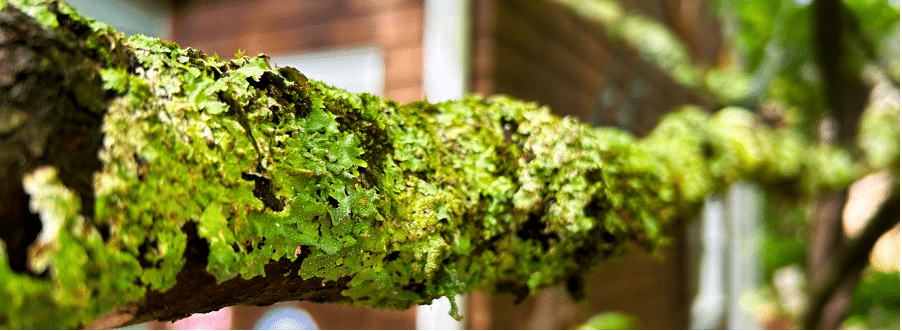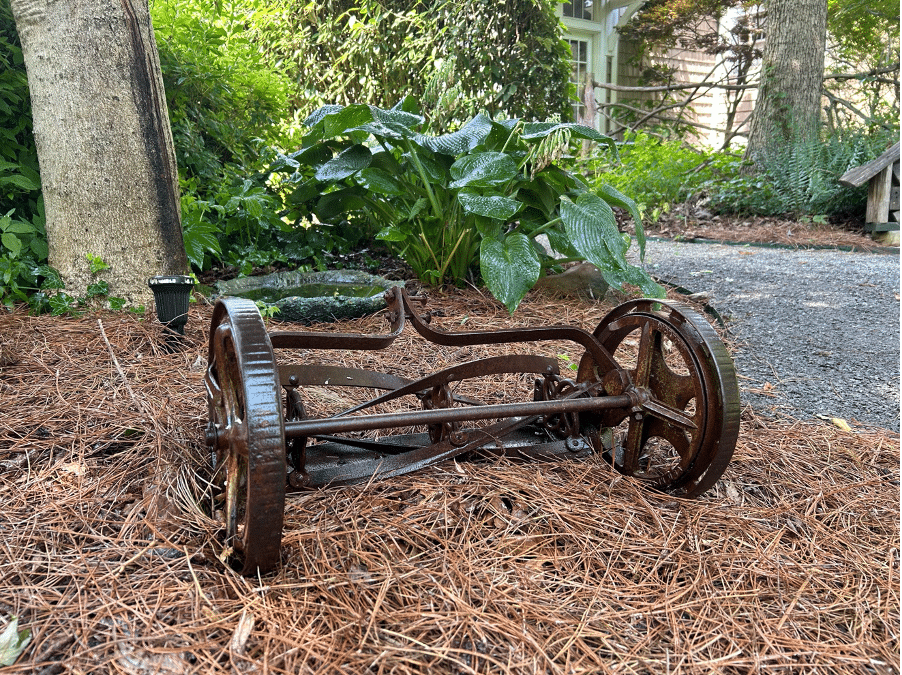Letting go of perfection and permanence

This is a branch on a dogwood just outside our back door. It came with the house we’ve now called home for 38 years. The growth of moss and lichens prompts me to associate it with the term misunderstood term “Wabi-sabi”.
I’ve never been one to seek out the difficult path. Like many, I am not opposed to taking on a challenge now and then but I know my strengths and they have led me to this point in life. When I began teaching in a “one-year, non-tenure track, don’t get your hopes up position at The University of Tennessee, I was told if I wanted a chance at staying longer I would at the very least need to get my master’s degree. OK. What’s the path of least resistance? I thought. I did that and then retired 33 wonderful years later.
Alright, you say. What’s this got to do with garden design? As these posts have been all over the board, I thought I’d take a stab at explaining an Eastern philosophy of art and design known to the Japanese as Wabi-sabi. Even if you glean nothing from the words about to materialize from these fingertips, that’s just plain fun to say! Wabi-sabi, Obe wan Kenobi! (Sorry, it’s Monday.) Taking a stab at explaining this may be an over-estimation. It’s more likely that I’ll just confuse you more.
If you Google “Wabi-sabi”, like I just did, you’ll find many different definitions. But I’ll boil that down for you, now that I have 45 minutes of experience under my belt. Wabi means “rustic simplicity”. Sabi is “beauty or serenity that comes with age”. Kind of like patina, I would guess. Other descriptions may include: beauty in imperfection, an appreciation of imperfect forms, and the beauty of simplicity. When I read that last one, I quickly understand that I’m out of my element here as I and all who know anything about me can attest that I am a “maximalist”. Organized clutter with a touch of OCD, is how I’m likely to be remembered.
The origin of the term Wabi-sabi probably dates back to the Endo period in your Japanese history books. While “Feng shui” is a Chinese philosophy describing the art of arrangement (please don’t ask me to go further), Wabi-sabi is most often associated with the Zen / Buddhist idea of “an appreciation of the forms and changes of natural and man-made landscapes.

Wabi-sabi or just an odd retired dude with too much time on his hands?
To help put this in perspective, picture rocks covered with moss and lichen, or allowing metals in your garden to weather and rust (not sure if you can hang a “Wabi-sabi” banner on that junked car in your front yard though). Some other images to pack into your brain may include the peeling bark of trees or letting some non-invasive plants go to seed rather than being too eager to cut them back. Flower petals from a nearby camellia sprinkled naturally over a just-swept sidewalk. I could go on and on but you probably have some urgent texts to send out so I’ll try to put an imperfect ribbon on this one and Wabi-sabi is more about seeing rather than explaining. (The Japanese claim that we Westerners diminish its meaning by talking about it so much!)
There are no rigid rules of Wabi-sabi but rather three basic principles:
Nothing lasts
Nothing is finished
Nothing is perfect
For OCD-leaning control freaks like myself, this is a tough concept to accept. Even for gardeners who darn well know that plants will grow and change over time, we all fight to keep that shrub at just the right height for the rest of its or our lifetimes with the help of our clippers and shears. On the flip side, it can be a little freeing to let go of our expectations of permanence, completeness, and perfection and have an appreciation of what we have right now rather than always anticipate what is to come. Some might call this mindfulness. (I’m a total hypocrite now!)

After a mirror fell off our back fence and shattered, I first cleaned it up and tossed in the bin. Then the creative in me dragged it out and made this. Art or Wabi-sab?
So, go out in your garden (perhaps with a nice beverage) and try to see with new, maybe slightly out-of-focus eyes. That’s not a garden gate that needs the rust scraped to be painted. That’s Wabi-sabi! Relax.
Till next time,
LET YOUR WABI LEAD YOUR SABI
Please share and subscribe! https://ahomeforyourgnome.com/
LAST WEEK’S TOOL CHALLENGE!
I have a little more to share for those who read my piece about favorite garden tools. Debbie tells me she is lost without her Fiskars Micro-tip pruning snips. Though she may want to consider attaching one of those bikers’ wallet chains to them as she confesses, she often loses them.
David sent me a nice pic of a wheelbarrow that he restored and had been his grandfather’s. Kaye sent me a photo of her hand cultivator (aka – backscratcher). My friend Brian whom I’ve known since kindergarten (yeah, that’s a 60-year friendship!) told me he has fond memories of an ultra-cool, three-pronged weeder that he used as a kid in Batavia, NY, and still uses today. Here are a few of those gems:

But perhaps the best response I received was when close friend and neighbor Marcia shared with me that her best “tool” is her husband, Tom! Tome DOES do a lot to help her around the garden and he can sometimes just be a “tool”. You win Marcia!
Thanks to all who responded and thank to all of you for taking the time to read my posts! One last request:
I am desperate to increase the readership of my site. SO….if you could possibly coax one (or more) of your fellow gardening friends into to visiting and clicking that elusive “subscribe” tab, I would be forever grateful. The person who sends the most new readers my way will receive a copy of my book that should arrive this week, A Home for Your Gnome. I know I’m biased but it’s GREAT! (As Tony the Tiger would say).

